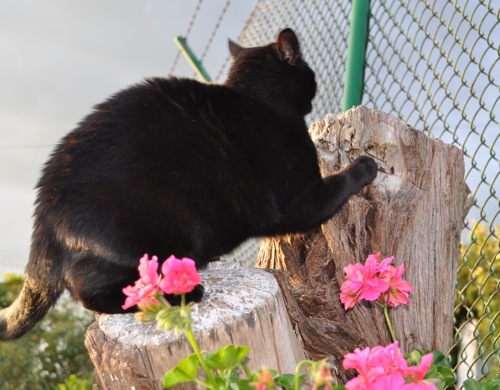Scratching is a natural behavior for cats. Cats scratch to stretch their muscles, shed old cuticle, sharpen their claws, and leave scent marks. Even declawed cats retain the instinct to scratch. Scratching posts let cats scratch while saving your furniture and carpets! Consider the following factors to choose the right scratching post for your cat:
What does your cat like to scratch?
Cats that scratch chair legs or the corners of your couch may prefer a vertical scratching post. Make sure that vertical scratching posts are tall enough so that your cat can stretch up to scratch. Cats that scratch rugs and carpets may prefer a horizontal scratching post or mat.
Choose a scratching post material that is similar to what your cat most likes to scratch. Most, but not all, cats prefer scratching posts made out of rough material they can shred. Sisal scratching posts are ideal because they are satisfying to scratch and tough enough to stand up to repeated use. Vertical or upright and horizontal or flat scratching posts are available in a variety of sizes and materials including sisal (a coarse natural fiber), carpet and cardboard. Be sure to get one that is high enough to let your cat get a good stretch, and sturdy enough not to fall over during use!
Where does your cat scratch?
Cats scratch to leave scent marks that define their territory and tell other cats they have passed through.They often scratch prominent objects near sleeping areas (so they can stretch after a nap) and room entrances, so think about adding scratching posts in these and other "public" parts of the house. Multi-cat households may need several scratching posts, both vertical and horizontal, located throughout the house. Put these posts in areas where the cats congregate, and along their routes to common areas such as food and water bowls, and litter boxes. Having multiple scratching posts provides your cats with acceptable places to leave their mark without ruining furniture and carpets.
What if my cat won't use the scratching post?
 Think about your cat's scratching preferences and substitute similar objects for her to scratch. Once you have found an alternative scratching post, place it near the object you want the cat to stop scratching and cover that object with something your cat doesn't like, such as double-sided sticky tape, aluminum foil, sheets of sandpaper, or a plastic carpet runner with the pointy side up.
Think about your cat's scratching preferences and substitute similar objects for her to scratch. Once you have found an alternative scratching post, place it near the object you want the cat to stop scratching and cover that object with something your cat doesn't like, such as double-sided sticky tape, aluminum foil, sheets of sandpaper, or a plastic carpet runner with the pointy side up.
You also may give objects you don't want scratched an objectionable odor by spraying a citrus scent, perfume, or other odor your cat doesn't like on it. Don't use anything that could harm the cat, and be careful with strong odors because you don't want the nearby acceptable objects to also smell unpleasant.
When your cat is consistently using the scratching post, you can very gradually (no more than three inches each day) move it to a location more suitable to you. It's best, however, to keep the scratching post as close to your cat's preferred scratching locations as possible.
Trimming your cat's nails
Nail trims are an easy, and often overlooked, way to reduce damage from scratching. You can clip off the sharp tips of your cat's claws about once a week. There are several types of nail trimmers designed especially for cats. These are better than your own nail clipper because they won't crush the nail bed.
Before trimming your cat's claws, accustom her to having her paws handled and squeezed. You can do this by gently petting her legs and paws while giving her a treat. This will help to make it a more pleasant experience.
Gradually increase the pressure so that petting becomes gentle squeezing, as you'll need to do this to extend the claw. Continue with the treats until your cat tolerates having her feet handled.When she is ready, apply a small amount of pressure to the cat's paw, with your thumb on top of her paw and your index finger underneath, until a claw is extended. Near the cat's nail bed you should be able to see a pink area, called the "quick", which is a small blood vessel.
Don't cut into the pink portion of the nail because it will bleed and be painful for the cat. Cut off just the sharp tip of the claw to dull the claw. Go slowly with your cat or she may become fearful of having her nails trimmed. To begin with, trim just one foot each day. As your cat becomes accustomed to having her nails clipped you can trim all four feet at the same time. There is a video here to show you how it is done.
If you prefer not to trim your cat's nails, you can purchase soft plastic caps that fit over the nail. Nail caps are available under the brand name Soft Paws and are available in a variety of sizes and colors. For more information on nail caps please visit www.catscratching.com

